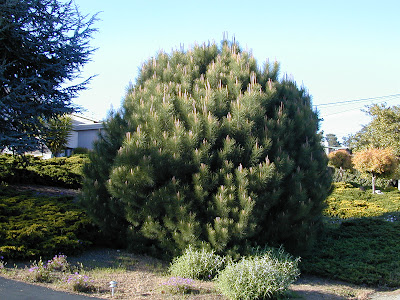I love this tree, especially when is has the room to grow and has some years under its belt. The form is way cool, broadly and shallowly domed, with numerous thick upright stems and awesome bark.
I hope I will live long enough to see Graham Hill Rd in SV with a mature stand, but until then I have to close my eyes as I drive by hoping they don't pull the trees because they interfere with trucks.
There is a nice example of this type of planting on Clubhouse Dr in RDM. Notice the lifting of the asphalt, oops.
Large evergreen conifer, slow to moderate growth rate to 40-80' with 40-60' spread. Mature trees are slightly domed shaped, with the majority of the foliage in the upper part of the tree. Main stem often branches low into multiple upright spreading primary scaffold branches. Or, it may make a single stemmed tree with the laterals up near the top of the canopy. This one is in Rome, looking out the Coliseum.
Here is an example of a young tree. Notice how wide and full it is. It will get wider as it gets taller also. But it is a pretty nice symmetrical ball at this age.
The leaves are clustered in groups of 2's, stiff, slightly twisted and not prickly, dark green, 4-7" long. Leaves last 3 years generally. Sheath is brown to gray, 1/4" long.
Foliage is held tightly against the stem. Notice how the leaves are laying down along the stem. A good thing to look at when ID-ing pines.
Cones are ovate shaped, 3-5", heavy and think, reddish brown when mature, opening almost round. Large thick scales reflex back to release the large edible seeds that you might know as pine nuts. Look at a cone on the ground and you will see that when they fall they usually leave a ring of scale behind on the tree, same as a ponderosa pine.
The bark is, well what can I say. The first picture is of me at Kew Gardens. Thick, reddish on the scales, dark brown to black in the furrows. What a nicer way to show off the bark that to have the foliage way up high.
Note sure how long this link will last but here is a picture of the tree from the kew gardens website
Here is a picture of a grove in a protected area in Spain. Really cool to see them in their natural habitat.
Misidentification:
P. cembrioides, very short needles, small tree, tiny cones with pinyon seeds.
P. controta, has very short leaves and very much smaller cones, not really common.
P. densiflora has very thin leaves and every much smaller cones as well as being clustered, less common as well.
P. halepensis has thin leaves, found on the freeways usually.
P. mugo, small shrub generally,
P. nigra, leaves dark, stiff, white buds, yellowish tan cones,
P. pinea, leaves thicker, stiffer, look for the leaves on new shoots on this one to be laying almost flat and forward as well as being retained longer.
P. sylvestris, bluish green leaves, distinctly twisted, smaller cones, reddish bark, not common.
P. thunbergii, thicker needles, often yellowish green, very sharp and usually twisted.
Location: Capitola: 4 or 5 nice ones in a row on Clares St south of 42nd Ave.
Scotts Valley: Potential on Graham Hill in SV.
Watsonville: Love the parking lot at Watsonville Memorial hospital on Airport Blvd.
Along the side of the County Building on Freedom.








